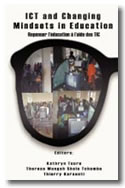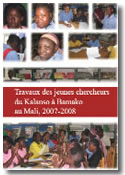What is so special about the African Institute for Mathematical Sciences or “AIMS”? September 26, 2011
I was asked as Regional Director of the International Development Research Centre (IDRC) of Canada to visit the African Institute for Mathematical Sciences (AIMS) in South Africa. This request was motivated by the Canadian government’s 2010 decision to  invest 20 million dollars, via IDRC, in the expansion of AIMS across the continent. I knew AIMS would be interesting, but I didn’t know how much so. I learned all that follows during encounters at AIMS centres in Cape Town, South Africa and Mbour, Senegal with AIMS students, lecturers, tutors, staff, and founders.
invest 20 million dollars, via IDRC, in the expansion of AIMS across the continent. I knew AIMS would be interesting, but I didn’t know how much so. I learned all that follows during encounters at AIMS centres in Cape Town, South Africa and Mbour, Senegal with AIMS students, lecturers, tutors, staff, and founders.
What then is so special about AIMS? Many things…
Getting inside the problem
Students told me that things are “different” at AIMS. I asked them what they meant. One young woman student explained that “we get inside the problem.”
“What do you mean,” I asked?
“I used to find the answer, without understanding the problem. Now I know how to get inside a problem, take it apart and understand it. Once I have done that, I can go to bed. I know that in the morning I will be able to solve the problem because I understand it.”
So many of us try to “solve” problems without first understanding them. Will AIMS students use the approaches they are learning to “get inside” and tackle the challenges of the continent?
Identifying and investing in human potential
Young university graduates from across the continent have been applying to AIMS since it opened in South Africa in 2003. And one third of AIMS students are women! One day maybe half will be women? AIMS receives hundreds of applications each year. Selection committee members cull through them and try to identify the students who would most benefit from advanced studies in mathematics. Entrance exams, which can eliminate good students who have not learned to take standardized tests, are not used.
But what does AIMS have to offer?
AIMS provides a full scholarship to all its students. And the ten months of postgraduate training helps students get into master’s and doctoral programs to further their studies. Universities increasingly recognize AIMS for quality education. AIMS is growing a “family” of graduates who will certainly generate knowledge and new theories to be applied in natural resource management, renewable energy options, health systems, business and more.
Youth from across the continent working across borders
AIMS students learn with peers from across the continent and lecturers from around the world. The relationship between learners and teachers is not a distant and hierarchical one. Students get to know their lecturers not just as scientists, but also as people. The atmosphere is caring and nurturing. Students deepen their understanding of math and build their self-confidence.
Networking scientists around theoretical and practical questions
AIMS is more than a school. It is a network of researchers interested in learning from and collaborating with each other. AIMS students go beyond their national and disciplinary boundaries in the pursuit of knowledge. The Institute supports and encourages work at the frontiers of thinking.
Pedagogically speaking?
Active learning methods! No one sits back. Lecturers are world experts in their fields. They build their courses based on the background and interests of students. There is a lot of co-construction of learning. And each student works on a project for the end of the program, the results of which are presented to their peers.
Educational continuum
At AIMS it’s not a matter of training young people and sending them out the door. Students are supported in searching for master’s and doctoral opportunities. AIMS also seeks to help alumni who complete their master’s degree or doctorate find positions in research laboratories and universities on the continent as well as opportunities within the private sector or government. In South Africa, concerned about the quality of pre-university teaching in science and mathematics, AIMS organizes training workshops for high school teachers across the country. Many educational initiatives in Africa have failed or left the educational system lopsided because of an overemphasis in one level of education to the detriment of others. Will the “holistic” approach of AIMS be different?
Daring to do things differently
In striving for societal change, AIMS dares to do some things differently. This is hard for some people to accept. Staff, students and lecturers however are incredibly patient when it comes to explaining AIMS. Alumni are its best spokespersons. Some of them return to AIMS as tutors – to help out academically and also to help keep alive and “pass on” the AIMS culture of excellence and solidarity.
What else?
The AIMS centres are located in attractive sites outside capital cities, so students have the serenity to delve into their studies. Internationally renowned scholars derive pleasure from travelling to these sites for three weeks of teaching. Being outside large cities also helps economise. AIMS staff are adept in coming up with creative strategies to work in financially under-resourced environments. They know how to do a lot with little. Which is important in making AIMS sustainable.
Students, lecturers, and ambassadors all at one table?!
Staff, lecturers and students share meals and eat together, taking AIMS interactions beyond the classroom. And this practice is extended to all visitors. When I attended an open house day at AIMS-South Africa, government authorities, ambassadors and financial supporters were invited to eat a modest but tasty meal in the cafeteria with students and lecturers. Others might have thought the “Very Important People” or “VIPs” would need a separate space of their own. But who is “important” after all if not the youth who will be responsible for the future of the continent? Aren’t there advantages in “mixing” as opposed to keeping things separate?
Mathematics and more
I see now that AIMS is about much more than mathematics. Yes, there are courses in pure mathematics, theoretical physics, computing, programming, and modelling in addition to support for written and spoken English and French. Research ethics and citizenship are also taught – in the classroom and over dinner. I don’t want to paint a picture of AIMS as perfect, because certainly no human endeavour is. It is a veritable challenge to midwife new AIMS centres, outside of AIMS’ birthplace in South Africa. But big ears and the important scientific act of observation assist in growing organically and gradually. Probably all too gradually for the AIMS founders and supporters, when they know how much there is to do on the continent and that the AIMS approach can help.
Related links :



Newton, Einstein, Hawking — they showed us the power of one beautiful mind to radically alter our understanding of the universe. Clarisse Uwizeye could be the next genius to turn science on its head, yet the world nearly lost her beautiful mind.
At age seven, Uwizeye barely escaped the genocide in her homeland of Rwanda, fleeing with her family to the Democratic Republic of Congo. Two years later, war came to Congo and the family had to run again, back to Rwanda. Her parents vanished, never to be seen again.
Fore more, see: http://www.kathryntoure.net/2013/09/12/aims-unleashing-africa%E2%80%99s-beautiful-minds/